Features of Epson Toyocom's Gyro Sensors
Features of Epson's Gyro Sensors
Let's take a look at how well Epson's gyro sensors perform for each of the keys to stability.
1. Low noise level
2. Stability over temperature
2-1. Bias stability over temperature
2-2. Scale factor stability over temperature
3. Vibration and shock resistance
3-1. Resistance to vibrations other than angular velocity
3-2. Shock resistance

1. Noise level
We measured the noise sensitivity of a typical Epson gyro sensor. The data in the graph below shows that the double-T structure employed by our gyro sensors achieves a low noise of 0.005 (°⋅s-1) /√Hz in the frequency band used by customers.
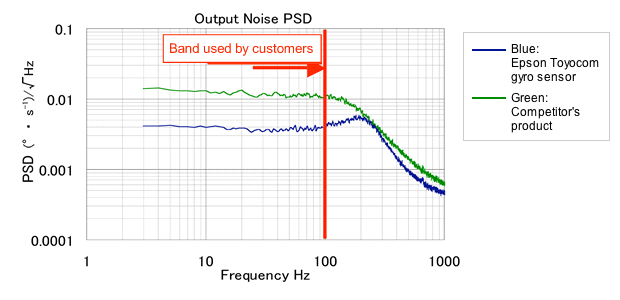
2. Stability over temperature
2-1. Bias stability over temperature
We measured the change in static bias (the value of the gyro sensor's output when there is zero angular velocity) of a typical Epson gyro sensor over a temperature range. The gyro sensor exhibits outstanding bias stability, as the double-T structure further accentuates the already good characteristics of the quartz crystal material.
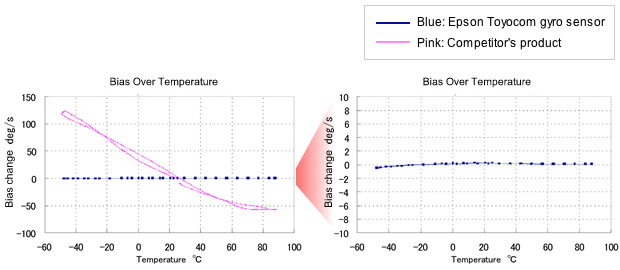
2-2. Scale factor stability over temperature
We measured the scale factor error of a typical Epson gyro sensor. The data is shown in the graph below. The gyro sensor exhibits outstanding scale factor stability over temperature because the driving arm and sensing arm can be formed on the same crystal plane of the quartz material, and planes that are the same exhibit the same temperature characteristics.
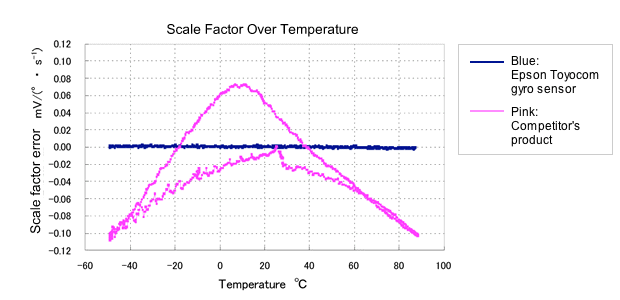
3. Vibration and shock resistance
3-1. Resistance to vibrations other than angular velocity
We measured the change in bias (the value of the gyro sensor's output when there is zero angular velocity) of a typical Epson gyro sensor when a 20 to 2,000 Hz vibration source was applied to the X, Y & Z axes. The data is shown in the graph below. The gyro sensor exhibits excellent bias stability versus external vibration.
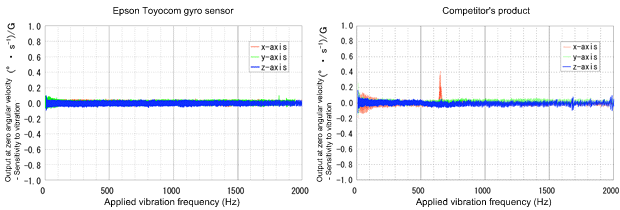
3-2.Shock resistance
We measured the change in bias (the value of the gyro sensor's output when there is zero angular velocity) of a typical Epson gyro sensor when a shock of 100 G's was applied to the X, Y & Z axes. The data is shown in the graph below. The gyro sensor exhibits excellent external shock stability.
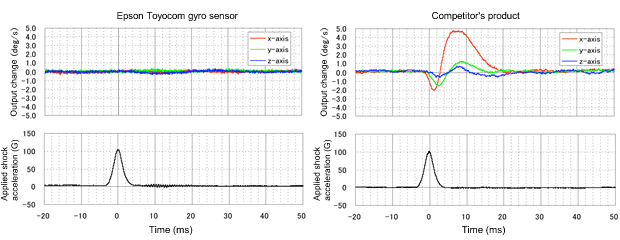
Structural modifications to the crystal unit have made Epson's gyro sensors exceedingly robust and resistant to effects from physical shocks.
We subjected our gyro sensors to harsh drop tests. Drop test data are plotted in the graphs.
Even after being dropped 10 times onto a concrete floor from a height of 2 meters, the gyro sensors exhibited almost no significant change in either scale factor or bias.
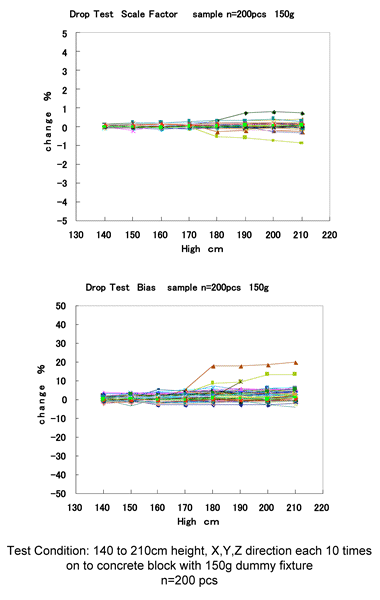

Epson's gyro sensors exhibit the five keys to stability thanks largely to the crystal element with the double-T structure and our original packaging technology.
The high stability of our gyro sensors enables them to help improve the performance of our customers' applications and reduce the number of times system-level calibration is needed compared to ordinary gyro sensors.
Epson's vibrating gyro sensors employ a quartz crystal element with a double-T structure.
| Material | Sample Structure | |
|---|---|---|
| Piezoelectric transducer |  |
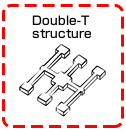   |
| Ceramic |   |
|
| Silicon transducer | Silicon | Si MEMS NOTE: Every company uses a different structure. |
Advantages of a single-crystal quartz element
• Ability to obtain high scale factor stability, since stable vibration with a high Q value can be obtainedZ
• Since the material is stable, there is minimal change over time.
• The uniformity of quartz means excellent reproducibility and precision during photo lithographic processing.
• Since Young's modulus is stable over the operating temperature range, we were able to produce a vibrating system that varies little with temperature.
Advantages of the double-T structure
• A high scale factor can be obtained because the Coriolis force can be used efficiently.
• Temperature characteristics are good because the quartz elements can be formed on the same excellent crystal plane of the quartz.
• Since the driving system and sensing system can be separated, there is minimal vibration coupling and a high signal-to-noise ratio.
• Good symmetry provides resistance to external vibration and shocks.
The material and structure of Epson's gyro sensors give them outstanding characteristics in each of the five key areas.
